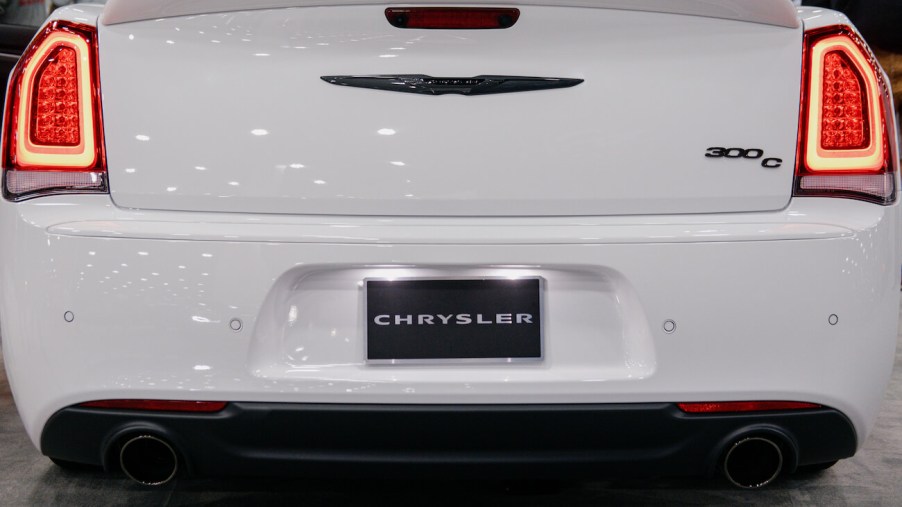
The Chrysler 300 Is Crawling to the Finish Line With Its Last and Worst Sales Year
Chrysler was once the name-bearer of one of the “Big Three” automakers in the U.S., alongside Ford and General Motors. Now under the Stellantis umbrella, Chrysler is in search of relevance much in the same way as its corporate cousins, Fiat and Buick, at least in the U.S. However, Buick is reinvigorating its lineup and Fiat is banking its hopes on EVs by ushering over its electric 500 model from Europe. But what’s Chrysler’s plan? The automaker can still rely heavily on the success of its Pacifica minivan, but the 300 sedan is being cut from the lineup, and the Chrysler 300’s sales in the last year seem to be its worst yet.
The Chrysler 300’s sales show a sedan that’s bowing out
The Chrysler 300 debuted for the 2005 model year and made an immediate splash. The full-size sedan (a wagon was also available in its early years of production) took plenty of inspiration, and even some components, from the Mercedes-Benz E-Class and S-Class, which is certainly a good place to start. But separating itself from its German inspiration, the 300 was fitted with a bulky V6, a 5.7-liter V8 or the SRT8 model, which cranked out 425 hp from a 6.1-liter Hemi V8.
Its stout styling commanded attention, and its power and performance netted it several prestigious awards, including MotorTrend’s Car of the Year upon its debut.
The hype translated to positive sales. Nearly 300,000 models were sold during its first two years on the market, and though sales declined in 2007, they still surpassed 120,000 units.
However, the Great Recession hit in 2008 along with surging oil prices, and a thirsty, large sedan didn’t hold the same level of appeal among buyers. Just 62,000 models were sold in 2008, and under 40,000 units sold each year from 2009 to 2011.
The second generation debuted for the 2011 model year and shared much of the same underpinnings as the first gen with updated styling and the new 300S upmarket model. An SRT model was also introduced, cranking out nearly 500 hp from a 6.4-liter 392 Hemi and more aggressive styling.
The model was slightly tweaked in 2015, but sales never recovered. Between 2013 and 2017, between 51,000 and 57,000 models were sold each year, but the 300 has been on a steady and rapid decline since.
Through June of this year, just 4,208 Chrysler 300 models have been sold, down from 4,837 units from June 2022. For perspective, the Pacifica outsold the 300 at a rate of 10-to-one over the first half of the year. Part of the reason why Chrysler 300 sales are so low could be attributed to Chrysler announcing last year the 2023 model would be the last for the 300.
The 2023 Chrysler 300 and the future of the brand
Many of the same pros and cons of the original Chrysler 300 can be used for the current model. It’s still a quiet, comfortable cruiser with powerful engine options, including the same 6.4-liter V8 from the Dodge Charger, cranking out 485 hp in the 300C variant. But it’s still a sedan, which can put many SUV-crazed buyers off, and it remains thirsty and not as refined as other full-sized sedans.
Pricing for the 2023 model starts at $35,890 MSRP for the Touring model, and it is topped by the 300C’s $56,595 starting price.
The death of the 300 marks a turning point for Chrysler as it looks to revitalize its lineup.
The brand’s electric Airflow concept crossover garnered plenty of attention with its sleek styling and ultra-modern cabin, but that model will not become a production reality. However, a replacement is in the works and could be revealed this year.
Reportedly, some of the Airflow’s design characteristics will be implemented in future Chrysler models. It’s not clear if that means some of the Airflow’s features, like its “Harmony in Motion” cabin, autonomous driving mode, “Chill Mode” during EV charging, or Chrysler Synthesis Virtual Assistant that were showcased on the Airflow, will be included in its purported replacement.
Beyond the immediate future, Chrysler has announced its plans to go fully electric by 2028.



